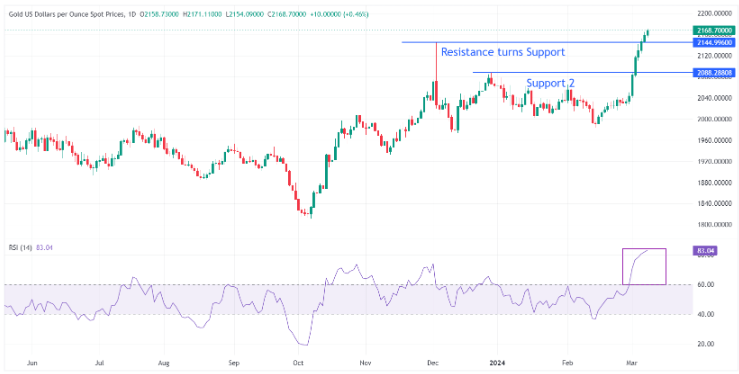- The price of gold reaches a new record high, surpassing $2,180, propelled by various favorable factors.
- The US Dollar experiences a decline due to sluggish wage growth and an increased Unemployment Rate in February.
- US Treasury yields take a significant dip as Federal Reserve Chair Powell provides a mildly dovish outlook on interest rates.
In Friday’s early New York session, Gold prices (XAU/USD) surge to a new record high, surpassing $2,180. The rally coincides with a decline in yields on 10-year US bonds to 4.04% following the release of the US Nonfarm Payrolls (NFP) data. The data reveals a notable deceleration in wage growth and a higher Unemployment Rate, fueling expectations that the Federal Reserve (Fed) may consider interest rate cuts in the upcoming June policy meeting.
According to the United States Bureau of Labor Statistics (BLS), the Unemployment Rate has risen to 3.9%, exceeding expectations, while Nonfarm Payrolls for February stand at 275K, surpassing projections of 200K but falling short of the previous reading of 353K.
The inflation outlook shows signs of cooling down, with Average Hourly Earnings growing at a slower pace than anticipated. Monthly wage growth registers a modest 0.1% increase, compared to January’s 0.6%, and falls short of the expected 0.3%. Annual wage growth decelerates to 4.3%, down from expectations and the previous reading of 4.4%. January’s wage growth has been revised down from 4.5%.
The combination of slower wage growth and a higher jobless rate exerts selling pressure on the US Dollar, with the US Dollar Index (DXY) touching a seven-week low around 102.40.
In the European session, Gold showcases strength as Fed Chair Jerome Powell signals the central bank is nearing confidence in inflation returning sustainably to the 2% target. During his two-day congressional testimony, Powell states, “We are waiting to become more confident that inflation is moving sustainably down to 2%. When we do get that confidence, and we’re not far from it, it will be appropriate to begin to dial back the level of restriction so that we don’t drive the economy into a recession.”
Daily digest market movers: Gold price rallies as US yields plummets after US NFP report
- Gold price reaches a fresh all-time high near $2,180, driven by a lower US jobless rate, slightly dovish remarks from Federal Reserve Chair Jerome Powell, and heightened geopolitical tensions.
- Jerome Powell, in a two-day congressional testimony, expresses policymakers’ proximity to gaining confidence in inflation returning to the 2% target, emphasizing the need to ease the restrictive monetary policy to prevent a recession.
- Gold’s rally signals increased investor confidence in the anticipation of earlier rate cuts following Powell’s mild dovish commentary. Expectations for Fed interest rate reductions in the June policy meeting remain steadfast, with rates expected to be maintained between 5.25% and 5.5% in the March and May meetings.
- New York Fed Bank President John Williams notes in an interview that restrictive monetary policy has exerted downward pressure on aggregate demand, and inflation expectations have slightly decreased.
- In the Middle East, the death of three civilians on a merchant ship in the Red Sea, attributed to Iran-backed Houthis, raises concerns about heightened geopolitical tensions in the region.
Technical Analysis: Gold price jumps above $2,180

Extending its winning streak into the eighth consecutive trading session on Friday, Gold price achieves new all-time highs above $2,180. The significant breakthrough involves surpassing a horizontal resistance line established from the December 4 high near $2,145.
The current trajectory of Gold indicates a prevailing bullish trend as it ventures into uncharted territory. However, caution is warranted as the asset may undergo a corrective move, considering that momentum oscillators have entered the overbought zone. The 14-period Relative Strength Index (RSI) registers at 83.00, well beyond the 70.00 threshold, signaling overbought conditions and hinting at potential correction in the near future.
Support levels on the downside are anticipated at the December 4 high near $2,145 and the December 28 high at $2,088.
